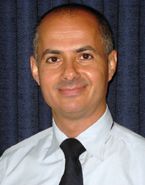Omar Yaghi's scientific empire, and the growing trend of satellite labs
October 8, 2012

 If you're interested in the future of how science is done, both in America and worldwide, then you must read this article from the September 28 issue of Science (subscription required): "Satellite Labs Extend Science."
If you're interested in the future of how science is done, both in America and worldwide, then you must read this article from the September 28 issue of Science (subscription required): "Satellite Labs Extend Science."
I'll give you a short version of the story: big name scientists at American universities want more funding for their ideas and more manpower than their current positions can provide. Institutions in "emerging nations" want talent and direction to improve their research programs. The result is a satellite lab, which operates under advisement from the long-distance faculty member, while the host country supplies the funding. The PI sets the research agenda and visits occasionally. There is usually a native surrogate on the ground in the satellite lab to run things from day to day.
The idea of global scientific cooperation is certainly not new. Research groups often collaborate across national boundaries, and universities partner with institutions around the globe to share faculty and students. However, this new model is neither a collaboration nor a partnership. If research groups were countries, we would call it colonialization. If they were restaurants, it would be like opening a new franchise.
One shining example of this new model is Omar Yaghi, the newly appointed director of the Molecular Foundry at LBNL and professor in the Department of Chemistry here at UC Berkeley. Yaghi has had a prolific academic career, including stints at Arizona State, University of Michigan, and most recently UCLA, before coming to Berkeley last year. More information about his research program can be found on his website, currently still hosted at UCLA.
Prof. Yaghi became well-known for developing the chemistry of metal-organic frameworks. What many people don't know is that he has two overseas research labs, in addition to his domestic lab. One group is part of the International Center for Materials Nanoarchitectonics (MANA) in Japan (extra credit challenge: try using "nanoarchitectonics" in a sentence); the other is the Center for Molecular and Nanoarchitecture (MANAR) in Vietnam.
A number of other notable scientists have adopted similar arrangements, including Chad Mirkin, Zhong Lin Wang, and Jim Heath. Yaghi is a major proponent of the satellite model, and he wants to spread the practice among other PIs. This effort has led the creation of a new center, funded by UC Berkeley, LBNL, and UCLA, called the Center for Global Mentoring (link to description in Science; the center doesn't have a website yet).
I think the rise of the satellite lab is a fascinating development in the way scientific research is organized, and I'd like to leave the conversation open for our readers to weigh in. What do you think about this trend? Is it mutually beneficial for the host institution and the home university?
Image courtesy yaghi.chem.ucla.edu.
![]() Service RF (2012). Global research universities. Satellite labs extend science. Science (New York, N.Y.), 337 (6102), 1600-3 PMID: 23019625
Service RF (2012). Global research universities. Satellite labs extend science. Science (New York, N.Y.), 337 (6102), 1600-3 PMID: 23019625



